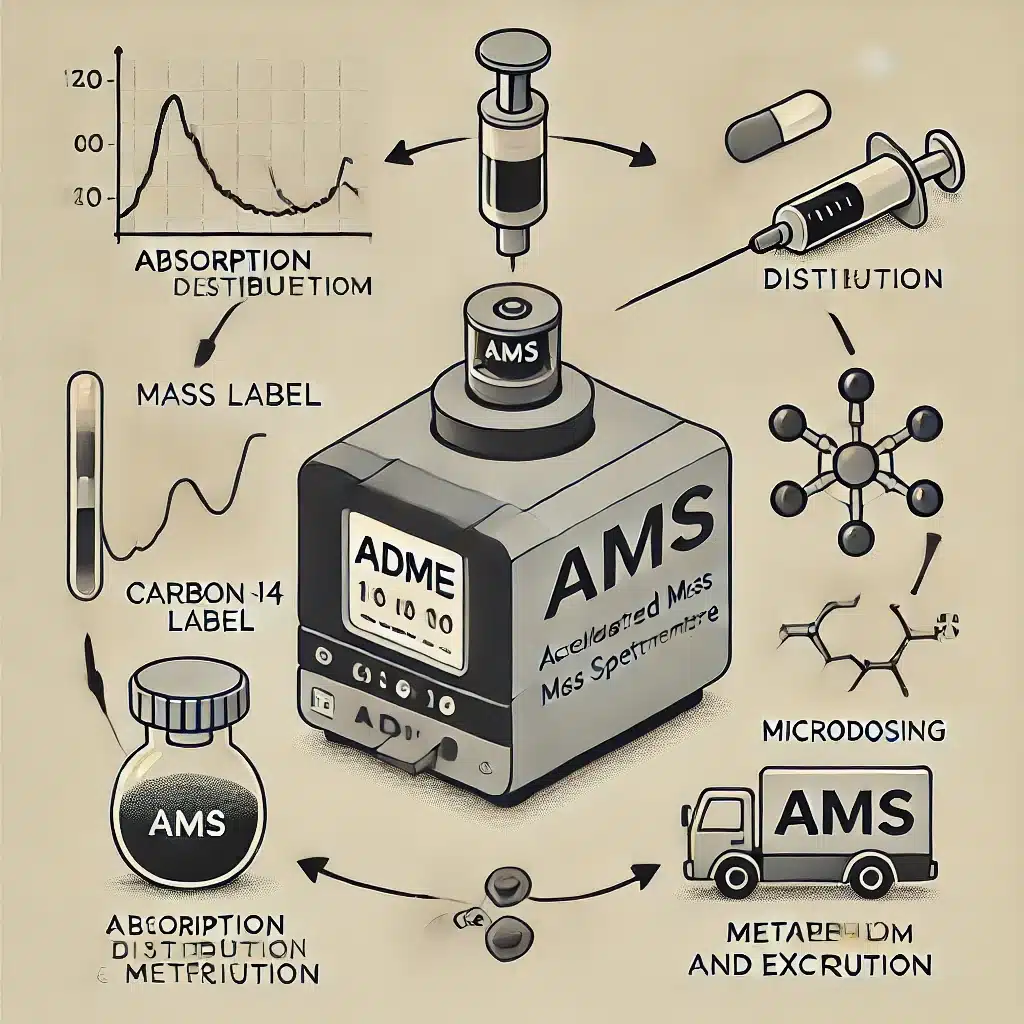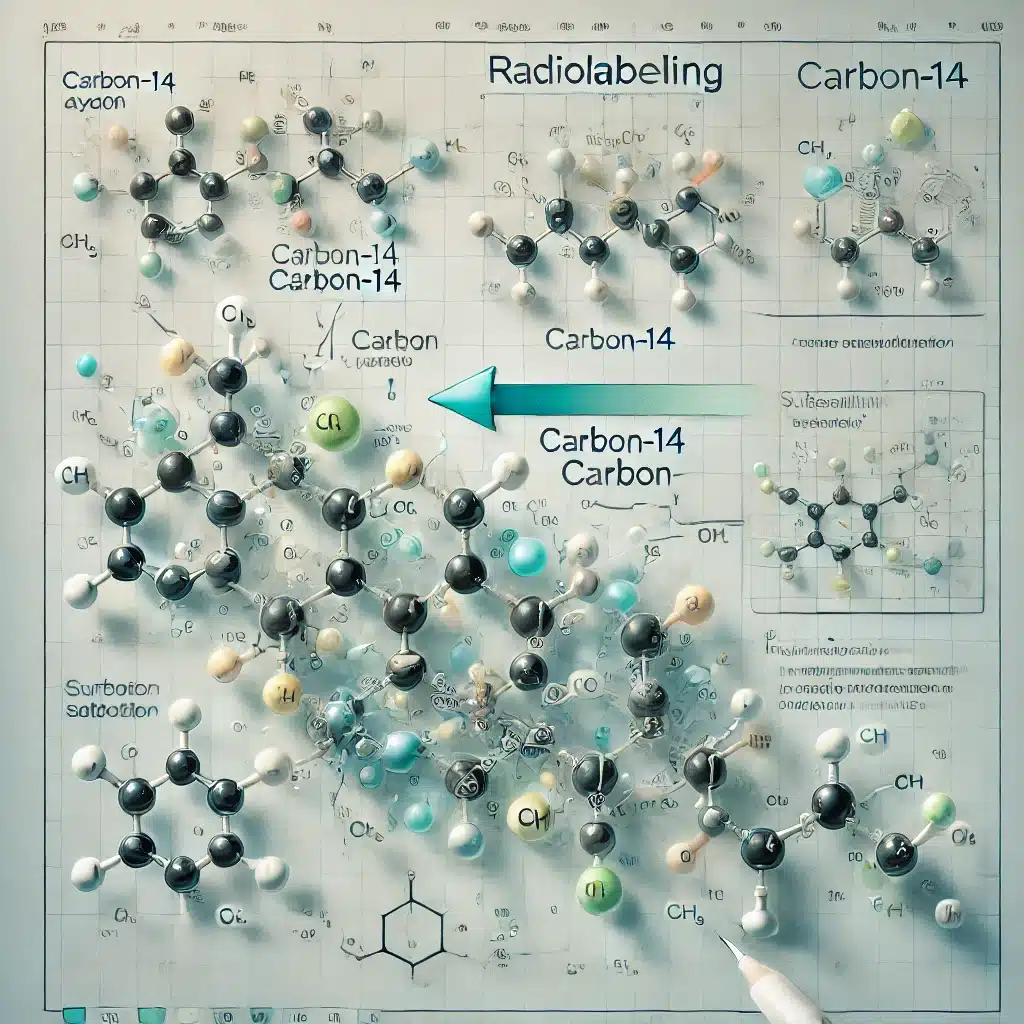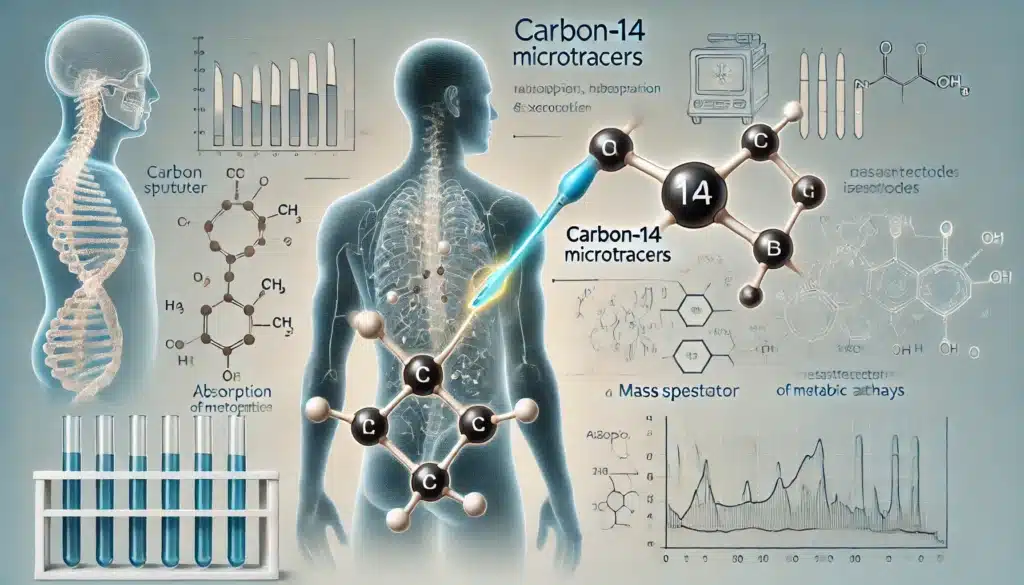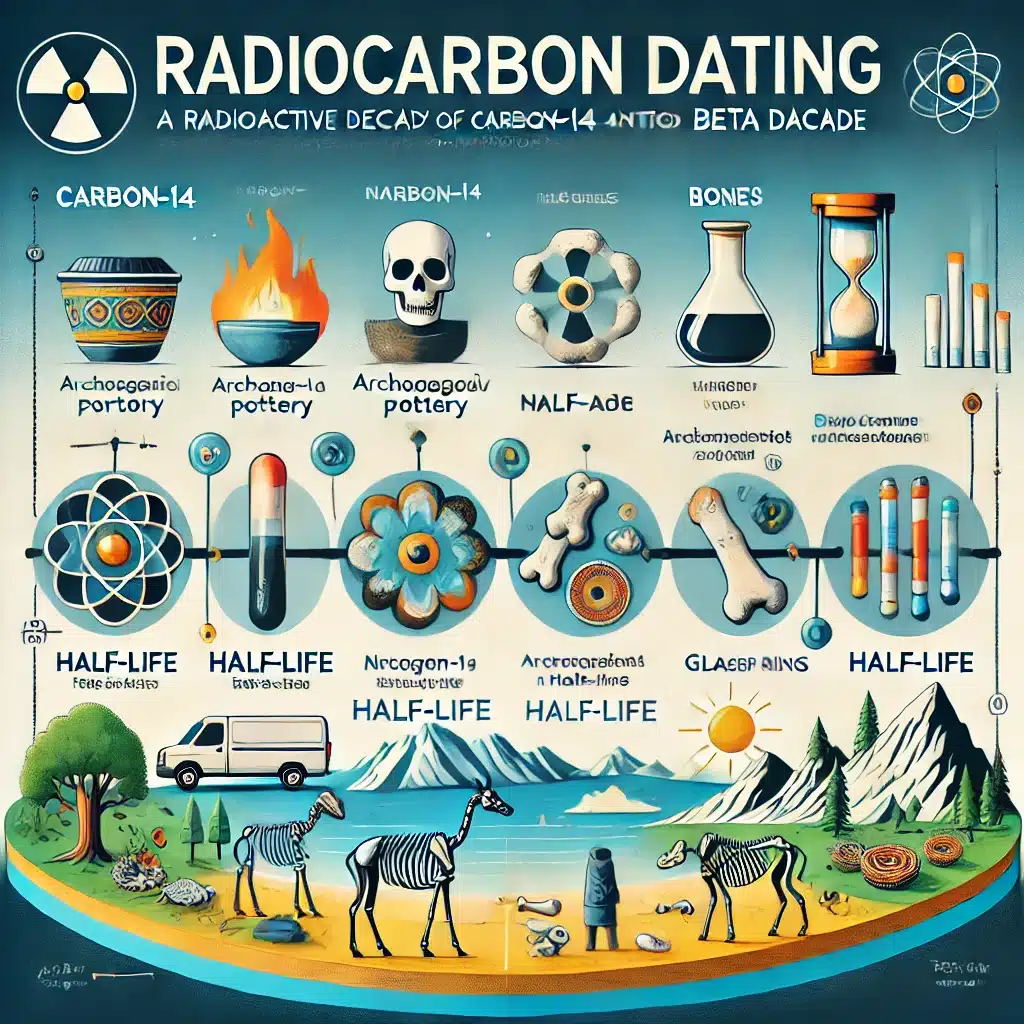Summary: Carbon-14 (C-14) radiolabelling plays a crucial role in pharmaceutical research, particularly in absorption, distribution, metabolism, and excretion (ADME) studies. However, the stability of C-14 labelled active pharmaceutical ingredients (APIs) is not always assured, as the radiolabel can undergo degradation or redistribution during synthesis, formulation, storage, or testing. This article examines the factors that affect the stability of C-14-labelled APIs, outlines best practices for their development and storage, and discusses analytical methods used to verify label integrity. A deeper understanding of the behaviour of C-14 under various chemical and physical conditions is essential to ensure data reliability in preclinical and clinical trials.
Keywords: Carbon-14, radiolabelling, active pharmaceutical ingredients, isotope stability, ADME studies, pharmaceutical development.
The Role of Carbon-14 in Pharmaceuticals
Carbon-14 is a radioactive isotope of carbon with a half-life of approximately 5,730 years, making it particularly valuable for long-term biological tracing studies. In the pharmaceutical industry, C-14 is widely used to label APIs to track their pharmacokinetics and metabolic fate in humans and animals. Its long half-life ensures consistent signal detection across study durations, and its chemical behaviour mirrors that of stable carbon, allowing for reliable incorporation into drug molecules.
The use of C-14 labelled compounds is particularly common in human mass balance studies and quantitative whole-body autoradiography. However, the utility of such compounds hinges on the assumption that the radiolabel remains stable and covalently attached to the API throughout the manufacturing, storage, and biological testing processes. When this assumption fails, the consequences can be significant, ranging from erroneous pharmacokinetic data to regulatory setbacks and compromised safety assessments.
Factors Affecting the Stability of Carbon-14 Labelled APIs
Chemical Environment and Isotopic Position
The stability of a C-14 label in a drug molecule depends mainly on its position within the molecular framework. Labels placed at metabolically stable sites, such as quaternary carbons or aromatic rings, are generally more robust than those located on labile functional groups, such as carbonyls, aldehydes, or methyl groups adjacent to electron-withdrawing moieties. The position of the label must be selected based on a thorough understanding of the molecule’s metabolic pathway to minimise the risk of cleavage or isotope loss.
Radiolysis and Autodegradation
Radiolysis refers to the degradation of a molecule caused by its own radioactivity. Although C-14 is a low-energy beta emitter and is significantly less prone to inducing radiolytic decomposition than isotopes like tritium, autodegradation over time can still pose a challenge, particularly at high specific activities or in poorly stabilised formulations. Radiolytic by-products may form via oxidative or radical-driven processes, altering the purity and integrity of the compound.
Storage Conditions
Temperature, light exposure, moisture, and oxygen all influence the rate of chemical degradation in radiolabelled APIs. To mitigate these risks, C-14 labelled compounds are typically stored under an inert atmosphere (e.g., nitrogen or argon), protected from light, and maintained at low temperatures, often in a freezer. Nonetheless, even under ideal storage conditions, long-term stability is not guaranteed and should be verified periodically using appropriate analytical techniques.
Formulation Considerations
When C-14 labelled APIs are incorporated into formulated drug products, excipients and processing methods can introduce additional variables. Acidic or basic excipients, high-shear mixing, and solvent interactions can all impact the chemical stability of the radiolabel. In such cases, extensive stability testing must be conducted not only on the API itself but also on the final product matrix.
Methods for Evaluating Radiochemical Stability
High-Performance Liquid Chromatography with Radiometric Detection
The most widely used method for assessing the stability of C-14 labelled compounds is high-performance liquid chromatography (HPLC) coupled with radiometric detection. This technique allows for the separation of labelled species and the identification of any degradation products. Radiochemical purity (RCP) is typically expressed as the percentage of total radioactivity corresponding to the parent compound, with regulatory expectations often requiring RCP values above 95%.
Mass Spectrometry and NMR Correlation
To support HPLC data, mass spectrometry (MS) and nuclear magnetic resonance (NMR) can be used to confirm the structure of both the parent compound and any impurities or degradation products. While these techniques do not directly detect radioactivity, they provide essential structural information that helps determine whether the C-14 label has remained at its intended position or has migrated during synthesis or storage.
Accelerated Stability Testing
In addition to real-time stability studies, accelerated testing under elevated temperature and humidity conditions can provide insight into potential degradation pathways. These studies help establish appropriate shelf lives and storage recommendations. However, care must be taken when extrapolating results, as radiolytic degradation may not always follow the same kinetics as non-radiolytic degradation.
In Vivo Validation
Ultimately, the most definitive assessment of radiolabel stability comes from in vivo studies. If the radiolabel is lost or redistributed in the body, it will appear in unexpected metabolites or tissues. Such findings often indicate problems with labelling site selection or unforeseen metabolic transformations. For this reason, thorough metabolic profiling using biological samples is a critical component of radiolabel validation.
Regulatory Expectations and Quality Assurance
Good Manufacturing Practice (GMP) and Documentation
The production of C-14 labelled APIs must be carried out under GMP or equivalent quality systems, particularly when intended for use in human clinical trials. This includes comprehensive documentation of synthesis, purification, quality control, and stability testing. Batch records must demonstrate that the radiochemical and chemical purity of the product meets regulatory standards throughout its intended shelf life.
Stability Protocols
Regulatory agencies, such as the MHRA, EMA, and FDA, expect sponsors to conduct formal stability studies on radiolabeled APIs, even when quantities are small. These studies should follow ICH guidelines as far as practical, with adaptations made for radiolabelled compounds. Acceptance criteria, testing intervals, and analytical methods must be clearly defined and justified.
Label Integrity Across Clinical Batches
For radiolabelled studies that span multiple cohorts or trial phases, consistency between batches is essential. If a new batch of C-14 labelled API is introduced mid-study, comparative data must be provided to show equivalence in radiochemical purity, isotopic position, and biological behaviour. Failing to do so could compromise the study’s validity and require repetition of critical phases.
Practical Challenges in API Radiolabelling
Synthetic Complexity and Cost
Radiolabelling with C-14 often involves multi-step synthesis, starting from isotopically labelled precursors such as barium carbonate or sodium bicarbonate. These building blocks are expensive, and their availability can limit the choice of labelling position. Furthermore, each synthetic route must be carefully optimised to avoid isotope dilution or loss, particularly during purification steps such as crystallisation or chromatography.
Waste Disposal and Contamination Risk
Handling C-14 compounds involves strict safety protocols to prevent contamination and ensure proper waste management. Unlike stable APIs, radiolabelled materials generate radioactive waste, which must be segregated, labelled, and disposed of according to national regulations. Even trace contamination can pose problems for analytical accuracy and environmental compliance.
Analytical Sensitivity
Although radiometric detection is highly sensitive, it requires calibration and validation for each compound and matrix. The signal-to-noise ratio can be affected by quenching, background radiation, and instrument stability. Additionally, very low specific activity preparations can challenge detection limits, particularly in complex biological matrices such as plasma or tissue homogenates.
Future Directions and Technological Advancements
Improved Isotope Chemistry
Recent developments in carbon-14 isotope chemistry have enabled more efficient and selective labelling strategies. Transition-metal-catalysed carboxylation, enzymatic transformations, and late-stage functionalisation methods have expanded the toolbox for incorporating C-14 into complex molecules. These advances reduce synthetic complexity, minimise isotope waste, and enhance overall stability by targeting metabolically inert sites.
Automation and Microdosing Integration
As microdosing studies become more common in early-phase drug development, the demand for ultra-trace analysis of C-14 labelled compounds has increased. Automated synthesis platforms and microscale purification systems help streamline the production of small quantities of high-purity radiolabelled APIs, which are suitable for human microdosing trials using accelerator mass spectrometry (AMS).
Predictive Stability Modelling
Computational chemistry and machine learning offer new ways to predict the stability of radiolabelled compounds. By analysing structural features, reaction kinetics, and historical data, these tools can identify labile positions and suggest more stable alternatives before synthesis begins. Such models could help reduce failure rates and improve the efficiency of radiolabelling programmes.
Conclusion
The stability of carbon-14 labelled active pharmaceutical ingredients is a cornerstone of reliable ADME studies and safe clinical research. Ensuring that the radiolabel remains covalently bound, chemically intact, and analytically verifiable throughout the drug development process requires careful planning, rigorous testing, and constant vigilance. With increasing regulatory scrutiny and the growing sophistication of radiolabelled studies, the industry must continue to refine its techniques and invest in technologies that support the integrity of C-14 APIs. By doing so, pharmaceutical researchers can continue to harness the power of radiotracers while maintaining the highest standards of safety and scientific accuracy.
Disclaimer
The information provided in this article is intended for educational and informational purposes only and does not constitute professional or regulatory advice. Open Medscience and the authors make every effort to ensure that the content is accurate and current at the time of publication; however, no guarantees are made regarding the completeness, reliability, or applicability of the information to specific circumstances. Readers are advised to consult appropriate regulatory guidance, institutional protocols, and qualified professionals when working with radiolabelled compounds or designing studies involving Carbon-14. Open Medscience accepts no liability for any loss, damage, or consequences arising from the use of information contained herein.




